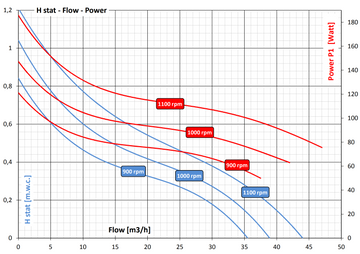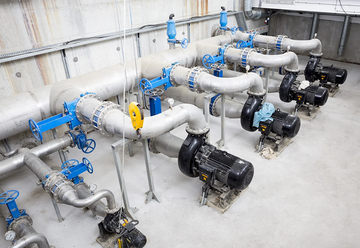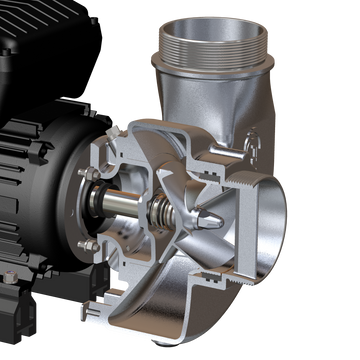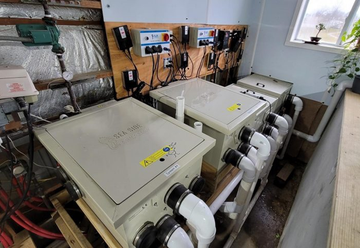What Are the Affinity Laws for Pumps?
What Are the Real Advantages of a Speed-Regulated Pump, Especially with a PMSM EC Motor?
One of the key benefits of a speed-regulated centrifugal pump lies in how significantly its performance changes with speed. By adjusting the speed, the pump can precisely match the required flow, ensuring that it does not deliver more than necessary. This is crucial for maximizing energy savings and improving overall system efficiency.
The real secret, however, lies in the motor technology.
A Permanent Magnet Synchronous Motor (PMSM) with Electronically Commutated (EC) control offers significantly higher efficiency compared to traditional asynchronous motors or even BLDC (Brushless DC) motors—especially at partial loads or lower speeds. This makes PMSM EC motors an ideal choice for applications where energy efficiency, performance, and variable speed control are critical.
The Affinity Laws explain how changing the speed (RPM) of a pump affects its flow rate, pressure, and power consumption. These laws apply mainly to centrifugal pumps, which are commonly used in things like water systems, heating, cooling — and garden ponds.
1. Flow rate increases directly with speed
If you double the speed, the amount of water the pump moves per minute (flow) also doubles.
2. Pressure increases with the square of the speed
If you double the speed, the pressure or head increases four times.
3. Power increases with the cube of the speed
If you double the speed, the energy the pump needs increases by eight times.
What Does That Mean in Practice?
Let’s say your pump is running at 1000 RPM, and you increase it to 1200 RPM:
-
The flow rate increases by 20% → more water movement
-
The pressure increases by around 44% → stronger push
-
The power consumption increases by about 73% → much higher energy use
So, even a small increase in speed means a big jump in energy use.
Why Is This Useful?
1. Save energy
By reducing the pump speed when full power isn’t needed, you can save a lot of energy — and lower your electricity bill.
2. Better control
You can adjust the pump to fit exactly what your system needs at any moment — not too much, not too little.
3. Lower installation costs
With a speed-controlled pump, you often don’t need a larger pump for peak demand — just increase the speed temporarily.
4. Less wear and tear
Lower speed = less stress on pump parts = longer lifespan and less maintenance.
Speed-Controlled Pumps vs. Traditional Flow Control (Valves)
In older systems, flow was often reduced by partially closing a valve. That restricts the water, but the pump still runs at full speed, using full energy.
With a variable speed pump, you reduce the actual speed of the motor, which means:
-
Less energy use
-
Quieter operation
-
Less wear on the pump
-
More efficient performance overall
It’s like using the gas pedal instead of the handbrake to slow down — much smarter.
How Does This Help with Garden Ponds in Winter?
During winter, pond fish are less active and don’t need much water circulation. A speed-controlled pump gives you major advantages:
1. Big energy savings
You can lower the speed to save 50% or more in electricity — while still keeping some water movement.
2. Calmer water for resting fish
Fish like to rest in still, cold water. Less flow helps them stay in their natural winter behavior.
3. Extend the life of your pump
Running the pump slower means less wear and longer lifespan — especially helpful in cold months.
4. Quiet, peaceful ponds
A slower-running pump is much quieter — ideal if you enjoy the calm of your garden in winter.
Summary of the Affinity Laws (No Math Needed)
-
Double the speed → Double the flow
-
Double the speed → Four times the pressure
-
Double the speed → Eight times the power used
Even a small speed change can make a huge difference in energy use and system performance.
Formulas:
The Affinity Laws show how changes in pump speed affect flow, pressure, and power.
1. Flow rate (Q) is directly proportional to speed (N):
Q₁ / Q₂ = N₁ / N₂
If speed doubles, flow rate doubles.
2. Pressure or head (H) is proportional to the square of the speed:
H₁ / H₂ = (N₁ / N₂)²
If speed doubles, pressure increases four times.
3. Power consumption (P) is proportional to the cube of the speed:
P₁ / P₂ = (N₁ / N₂)³
If speed doubles, power use increases eight times.
Formula Variables Explained
-
Q = Flow rate (e.g., liters per minute)
-
H = Head or pressure (e.g., meters of water column)
-
P = Power (e.g., watts or kilowatts)
-
N = Rotational speed (e.g., revolutions per minute – RPM)





